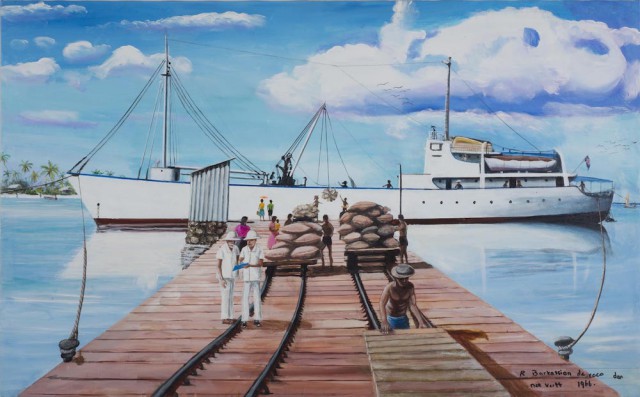Art & Exhibitions
At Simon Preston, Clement Siatous’s Self-taught Conceptualism
THE DAILY PIC: Exiled from his Chagos homeland, Siatous documents what was there.

THE DAILY PIC: Exiled from his Chagos homeland, Siatous documents what was there.

Blake Gopnik


THE DAILY PIC (#1392): This painting is by Clement Siatous, born on the Chagos Islands in 1947, and it’s part of an important solo show that recently opened at Simon Preston Gallery in New York, where it was curated by Paula Naughton. Although Siatous is self-taught, it’s important to realize that he’s not another one of those “outsider” artists that the art world is in love with right now.
Despite a superficial look of naïve outsiderism, his work in fact fits in with the political and documentary trends of the last 30 years of contemporary art. His paintings of labor and boats on his home islands need to be considered alongside the knowing labor and fishing photos of Allan Sekula, not the wild imaginings of Henry Darger.
As I understand it, Siatous’s paintings are reflections of the life he left behind on Chagos when he and every one of his neighbors were exiled from that Indian Ocean archipelago in the 1960s and early ‘70s. Despite much (living, breathing) evidence to the contrary, the British overlords had declared the islands uninhabited, so as to hand them over to the U.S. for use as a military base. They proceeded to make their declaration come true.
Living in exile between Mauritius and Britain, Siatous uses his paintings as unimpeachable documents of the life he and his people were forced to leave behind, and of the true inhabitation of the home taken from them.
Siatous follows a process that any conceptualist would be proud of: He chooses a very particular place and instant in the pre-exile past of Chagos, and then does his very best – I’m told a very accurate best – to recreate the scene, as he remembers and can document it. His paintings are political and informational objects rather than traditional esthetic ones. (Although for me they also have a hint of John Baldessari’s procedural art.)
That means that they shouldn’t be appreciated according to the criteria usually applied to outsider art – as “directly expressive”, as “innocently joyful,” as “escaping from deadening conventions”. (As I’ve argued before, those are terms used by Western modernism – still alive and well in some quarters today – to appropriate and assimilate the art of outsiders. Their works are treated as aesthetic objets trouvés that ignore their original meanings and functions.)
The particular style and look of Siatous’s pictures should be seen as irrelevant; they could have been painted utterly differently, either better or worse. What matters is that they were painted just well enough to give simple, transparent access to the information they carry and bear witness to. They function as true-enough documents of injustices done, no more nor less than that.
That makes them important, and cutting-edge. (Image courtesy the artist and Simon Preston Gallery, New York)
For a full survey of past Daily Pics visit blakegopnik.com/archive.